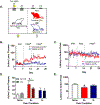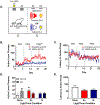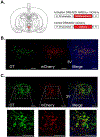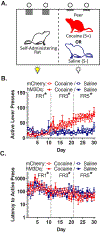Peer-induced cocaine seeking in rats: Comparison to nonsocial stimuli and role of paraventricular hypothalamic oxytocin neurons
- PMID: 36001434
- PMCID: PMC9413367
- DOI: 10.1111/adb.13217
Peer-induced cocaine seeking in rats: Comparison to nonsocial stimuli and role of paraventricular hypothalamic oxytocin neurons
Abstract
The purpose of this study was to determine if social vs nonsocial cues (peer vs light/tone) can serve as discriminative stimuli to reinstate cocaine seeking. In addition, to assess a potential mechanism, an oxytocin (OT) promoter-linked hM3Dq DREADD was infused into the paraventricular nucleus of the hypothalamus to determine whether peer-induced cocaine seeking is decreased by activation of OT neurons. Male rats underwent twice-daily self-administration sessions, once with cocaine in the presence of one peer (S+) and once with saline in the presence of a different peer (S-). Another experiment used similar procedures, except the discriminative stimuli were nonsocial (constant vs flashing light/tone), with one stimulus paired with cocaine (S+) and the other paired with saline (S-). A third experiment injected male and female rats with OTp-hM3Dq DREADD or control virus into PVN and tested them for peer-induced reinstatement of cocaine seeking following clozapine (0.1 mg/kg). Although acquisition of cocaine self-administration was similar in rats trained with either peer or light/tone discriminative stimuli, the latency to first response was reduced by the peer S+, but not by the light/tone S+. In addition, the effect of the conditioned stimulus was overshadowed by the peer S+ but not by the light/tone S+. Clozapine blocked the effect of the peer S+ in rats receiving the OTp-hM3Dq DREADD virus, but not in rats receiving the control virus. These results demonstrate that a social peer can serve as potent trigger for drug seeking and that OT in PVN modulates peer-induced reinstatement of cocaine seeking.
Keywords: cocaine; oxytocin; self-administration; social peer.
© 2022 Society for the Study of Addiction.
Conflict of interest statement
Figures






Similar articles
-
Renewal of cocaine seeking using social and nonsocial contextual stimuli.Psychopharmacology (Berl). 2025 May;242(5):945-953. doi: 10.1007/s00213-023-06414-7. Epub 2023 Jul 1. Psychopharmacology (Berl). 2025. PMID: 37391496
-
Social reinstatement: a rat model of peer-induced relapse.Psychopharmacology (Berl). 2018 Dec;235(12):3391-3400. doi: 10.1007/s00213-018-5048-8. Epub 2018 Oct 6. Psychopharmacology (Berl). 2018. PMID: 30291403 Free PMC article.
-
Attenuated cocaine-seeking after oxytocin administration in male and female rats.Psychopharmacology (Berl). 2018 Jul;235(7):2051-2063. doi: 10.1007/s00213-018-4902-z. Epub 2018 Apr 18. Psychopharmacology (Berl). 2018. PMID: 29671014 Free PMC article.
-
Oxytocin Reduces Cocaine Cued Fos Activation in a Regionally Specific Manner.Int J Neuropsychopharmacol. 2017 Oct 1;20(10):844-854. doi: 10.1093/ijnp/pyx058. Int J Neuropsychopharmacol. 2017. PMID: 28977525 Free PMC article.
-
Potential role for the hypothalamo-pituitary-adrenal axis in the conditioned reinforcer-induced reinstatement of extinguished cocaine seeking in rats.Psychopharmacology (Berl). 2002 May;161(3):222-32. doi: 10.1007/s00213-002-1007-4. Epub 2002 Apr 4. Psychopharmacology (Berl). 2002. PMID: 12021825
Cited by
-
Renewal of cocaine seeking using social and nonsocial contextual stimuli.Psychopharmacology (Berl). 2025 May;242(5):945-953. doi: 10.1007/s00213-023-06414-7. Epub 2023 Jul 1. Psychopharmacology (Berl). 2025. PMID: 37391496
References
-
- Pelloux Y, Giorla E, Montanari C, Baunez C. Social modulation of drug use and drug addiction. Neuropharmacology. 2019;159:107545. - PubMed
Publication types
MeSH terms
Substances
Grants and funding
LinkOut - more resources
Full Text Sources
Medical

